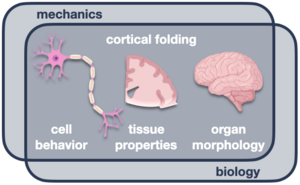Research
Our lab is currently working to understand the role of mechanics in two of the most complex systems in the body - the brain and the immune system.
The mechanics of the developing brain

Cortical folding, also called gyrification, occurs due to the proliferation of neurons in the cortex, generating compressive stresses and leading to buckling instabilities, potentially under additional influence from tension in axonal connections and/or local variations in neuronal proliferation. We study several aspects of the complex process of brain development, trying to answer the following questions:
What determines the pattern of cortical thickness across the brain?
It has been known for at least a century that gyri, the outer folds of the cortex, tend to be thicker than the inner folds, called sulci. But why?
How do patterns of cortical thickness change throughout development and across species?
In adults, cortical thickness varies locally from 1mm to nearly 5mm. How do those differences emerge throughout development? How similar are these patterns to non-human primates and other mammals?
How do soft layered materials like the brain buckle and fold?
The brain consists of two tissues, called white and gray matter; in addition to distinct cell composition and neurological function, these two tissues also have different material properties. In bi- or multilayered systems such as this, how do the materials interact in instabilities?
The mechanics of inflammatory swelling

Inflammation is a prevalent phenomenon across the body in response to illness, insult, and injury, resulting in local changes in mass (for instance, due to an influx of cells) which can manifest as changes in volume and/or pressure. Inflammation is widespread among different tissues, and these sequelae can have important implications for the diagnosis, development, and treatment of different diseases. In our mechanics-based investigation of inflammatory swelling, we plan to focus on two main questions:
How does swelling indicate immune activity?
When you got your last vaccine, did your arm swell up locally? You may have assumed that this meant your immune system was working hard in response to the vaccine, but is the relationship between swelling and immune activity really so straightforward?
How does swelling affect immune activity?
The proper functioning of the immune system depends on the ability of cells to travel throughout the entire body. What happens if something hinders this motion, such as changes in tissue porosity, collapsed vessels, or strong pressure gradients?